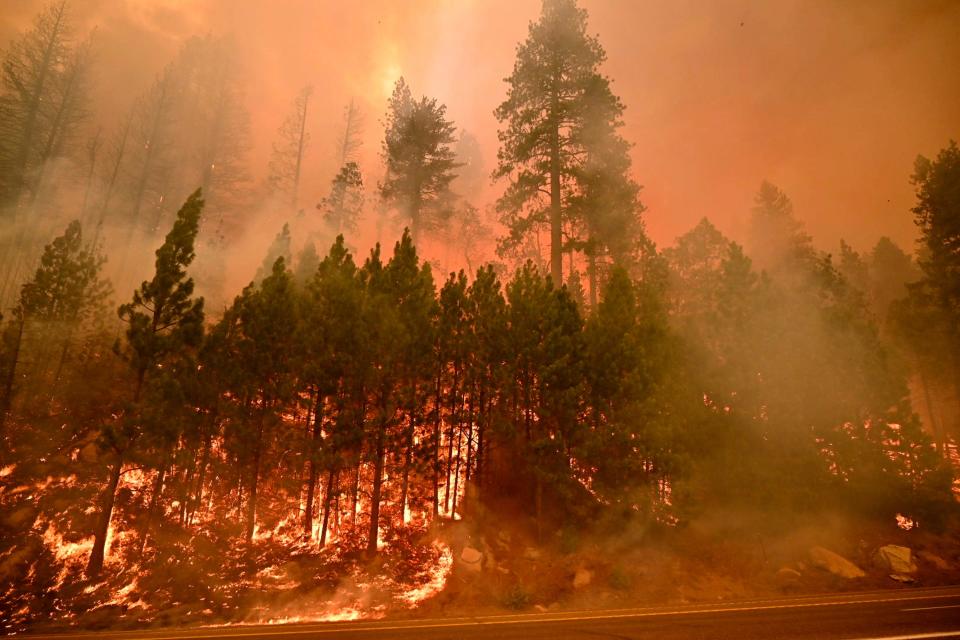Evacuation warnings issued in Lake Tahoe basin as Caldor Fire nears, tourists advised to stay home
STOCKTON, Calif. — A massive wildfire grew closer to iconic Lake Tahoe Thursday, spurring the first evacuation warnings for those inside the Tahoe basin and recommendations that tourists wanting to visit the area should stay home.
The Caldor Fire has grown to more than 139,000 acres on a trek that also destroyed the small town of Grizzly Flats. It was 12% contained Thursday evening and its growth toward Lake Tahoe, the popular vacation spot featuring picturesque beaches, emerald-blue waters, rocky shorelines and stunning landscapes in the Sierra Nevada, made the blaze the No. 1 priority nationally for firefighting resources.
Assigned resources have grown to nearly 2,900 firefighters, 21 helicopters, 245 engines and dozens of bulldozers since the early days of the fire, which began Aug. 14. Ongoing damage assessments have counted about 650 homes, businesses and other structures destroyed so far. Another 18,000 structures were still in danger.
The edge of the Caldor Fire was less than 15 miles southwest of the lake, according to data from the National Oceanic and Atmospheric Administration's GOES satellite published by Google.
Fire officials issued new evacuations Thursday that included areas inside the Lake Tahoe basin. Christmas Valley, which sits beneath the steep summit in the basin, was given an evacuation warning while those in the nearby Twin Bridges and Echo Summit areas, a little more than 10 miles south of Lake Tahoe, were told to leave immediately.
The Lake Tahoe Visitors Authority, the area's tourism agency, recommended on Thursday that visitors should "postpone any immediate travel plans to the area until further notice," a sure blow to the area where its tourist economy was in full swing.
“This is the week before Labor Day weekend — a busy weekend, normally,” South Lake Tahoe City Manager Joe Irvin said. “That is not going to be the case this year.”
More on the threat to Lake Tahoe: Caldor Fire, 'knocking on the door' of Lake Tahoe area, becomes nation's 'No. 1 priority for firefighting resources'
'It’s definitely not working': Wildfires are burning up trees meant to fight climate change
The normally stunning views of the freshwater lake were replaced by a thick, suffocating yellow haze and ash that pelted visitors.
Ramona Trejo said she and her husband came to Tahoe to celebrate their 50th wedding anniversary. They escaped the unhealthy air to play the slots inside the Hard Rock Hotel & Casino.
Trejo, who uses supplemental oxygen because of respiratory problems, said her husband wanted to keep gambling. “I would want to go now,” she said.
South of Tahoe, Rick Nelson and his wife, Diane, had planned to host a weekend wedding at Fallen Leaf Lake, where his daughter and her fiancé had met. But the smoke caused most of the community to leave.
The Nelsons spent two days arranging to move the wedding from the glacial lake several hours southwest to the San Francisco Bay Area.
Related: Smoke fills the sky over Lake Tahoe as crews fight to keep Caldor Fire from closing in

“Everybody’s trying to make accommodations for the smoke. And I think it’s becoming a reality for us, unfortunately,” Diane Nelson said.
Crews had hoped the soaring granite cliffs separating the blaze from the Tahoe basin would shield the lake and nearby communities, which include many resorts. But officials said the blaze, like others across the state, had already been proving them wrong. They have remained hopeful the fire would be stopped before actually reaching the Lake Tahoe basin.
Echo Summit, a mountain pass where cliff-hanging U.S. Route 50 begins its descent toward Lake Tahoe, is where firefighters plan to make their stand if the Caldor Fire keeps burning through dense forest in the Sierra Nevada.
Firefighters were facing changing weather conditions that could push the fire closer to the Tahoe Basin, a home to thousands and recreational playground for millions of tourists who visit the alpine lake in summer, ski at the many resorts in winter and gamble at its casinos year-round.
Winds and temperatures were expected to pick up in coming days while humidity drops, said Daniel Berlant, assistant deputy director of the state firefighting agency.
“That’s what’s closing the window of opportunity we’ve had to make progress and really get hold of the fire,” Berlant said.
Highway 50, one of only two roads used to access the Lake Tahoe area from California, remained closed in several areas as the blaze flared nearby. Fire crews fought several small blazes that erupted across the highway, hoping to prevent its spread.
Statewide there were 14 large fires, including a blaze that erupted Wednesday in Southern California, which has so far escaped the scale of wildfires plaguing the north all summer.
The South Fire, about 45 miles east of Los Angeles, has covered 700 acres after destroying 18 homes, commercial and other structures. Fire activity decreased after the early hours but it remained uncontained on mountain slopes.
In the southern Sierra Nevada, the 9-day-old French Fire covered more than 34 square miles and was 19% contained. Some structures were seen burning in Sequoia National Forest and it posed threat to numerous communities on the west side of Lake Isabella, a popular outdoor recreation area northeast of Bakersfield, California.
Meanwhile, California’s Dixie Fire, the second-largest in state history at 1,167 square miles was 45% contained in the Sierra-Cascades region, about 65 miles north of the Caldor Fire. Nearly 700 homes were among almost 1,300 buildings that have been destroyed since the fire began in early July.
Nationally, 88 large fires were burning Thursday in 13 mainly Western states, according to the National Interagency Fire Center in Boise, Idaho.
Contributing: Associated Press
This article originally appeared on USA TODAY: Caldor Fire nears Lake Tahoe: Evacuation warnings begin, tourists told to stay home

